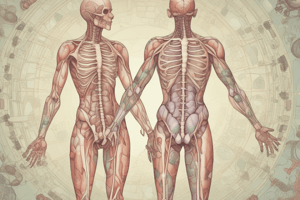Podcast
Questions and Answers
What is the primary therapeutic use of antihistamines?
What is the primary therapeutic use of antihistamines?
- To activate the immune response
- To increase the production of antigens
- To interfere with the action of histamine (correct)
- To enhance the action of histamine
Which of the following statements about histamine is true?
Which of the following statements about histamine is true?
- Histamine acts as an effective medication for allergies.
- Histamine itself has no clinical applications. (correct)
- Histamine has significant side effects when used therapeutically.
- Histamine is used in many clinical applications.
Which of the following is NOT associated with physical trauma?
Which of the following is NOT associated with physical trauma?
- Chemical exposure
- Severe tissue damage
- Emotional stress response (correct)
- Antigen-antibody reaction
What is a common component involved in immune responses?
What is a common component involved in immune responses?
Which process involves the interaction between a foreign substance and antibodies?
Which process involves the interaction between a foreign substance and antibodies?
What is the result of mast cell destruction in the context of tissue damage?
What is the result of mast cell destruction in the context of tissue damage?
What is the primary effect of histamine release on blood vessels at the site of injection?
What is the primary effect of histamine release on blood vessels at the site of injection?
Which of the following describes the direct action of histamine after mast cell destruction?
Which of the following describes the direct action of histamine after mast cell destruction?
Which cellular component is primarily involved in the release of histamine?
Which cellular component is primarily involved in the release of histamine?
What initiates the process of vasodilatation following tissue injury?
What initiates the process of vasodilatation following tissue injury?
What is a consequence of the trauma of prick on blood vessels?
What is a consequence of the trauma of prick on blood vessels?
Which substance is released due to a prick trauma that affects blood vessels?
Which substance is released due to a prick trauma that affects blood vessels?
What is the role of the triple response of Lewis in the context of a prick trauma?
What is the role of the triple response of Lewis in the context of a prick trauma?
How does the extent of the response to prick trauma compare to a histamine injection?
How does the extent of the response to prick trauma compare to a histamine injection?
What condition does increased blood vessel permeability typically lead to following a prick?
What condition does increased blood vessel permeability typically lead to following a prick?
What is the source of internal histamine release in the body?
What is the source of internal histamine release in the body?
What effect does adrenaline have on capillary permeability?
What effect does adrenaline have on capillary permeability?
How does external histamine differ from internal histamine?
How does external histamine differ from internal histamine?
What role does histamine play in the body's response?
What role does histamine play in the body's response?
What type of receptor does adrenaline primarily act on?
What type of receptor does adrenaline primarily act on?
What is described as a physiological antagonist to endogenous histamine?
What is described as a physiological antagonist to endogenous histamine?
Which observation is associated with the action of the physiological antagonist mentioned?
Which observation is associated with the action of the physiological antagonist mentioned?
What is NOT a characteristic effect when using the physiological antagonist to histamine?
What is NOT a characteristic effect when using the physiological antagonist to histamine?
In the context of allergic reactions, which effect is generally absent when the physiological antagonist is applied?
In the context of allergic reactions, which effect is generally absent when the physiological antagonist is applied?
Which of the following statements is true regarding the physiological antagonist to histamine?
Which of the following statements is true regarding the physiological antagonist to histamine?
Flashcards are hidden until you start studying
Study Notes
Physical Trauma
- Physical trauma can trigger the release of histamine, a substance involved in inflammatory responses.
- Trauma can come in various forms, like pricking or injections.
- The extent of histamine release is dependent on the severity of the trauma.
Antigen-Antibody Reaction
- Antigen-antibody reactions can also trigger histamine release.
Various Chemicals
- Histamine itself has limited direct clinical applications but can be influenced by other chemicals.
- Antihistamines are medications designed to counteract the effects of histamine, playing important roles in treatment.
Mast Cell Destruction
- Mast cells are important cellular components in the immune system.
- Destruction of mast cells can lead to the release of histamine, contributing to inflammation.
Histamine Effects
- Histamine causes vasodilation, which is the widening of blood vessels.
- It also increases vascular permeability, allowing for more fluid to leak out into the surrounding tissue.
Histamine Release
- Pricking releases endogenous histamine, which is produced by the body.
- Injecting histamine causes a more significant release compared to pricking.
Adrenaline
- Adrenaline (epinephrine) is a hormone that acts as a vasoconstrictor, meaning it narrows blood vessels.
- It counteracts the effects of endogenous histamine, resulting in reduced redness and swelling.
- While adrenaline can reduce histamine effects on the skin, it might cause paleness around the injection site.
Studying That Suits You
Use AI to generate personalized quizzes and flashcards to suit your learning preferences.





